Aug 01, 2010Newmans Valve doesn't make designer handbags, new-release DVDs or prescription narcotics, but the Stafford, Texas-based company's products were the victim of counterfeiting one too many times. Newmans manufactures specialty valves for use in oil refineries, chemical factories, desalinization facilities and a host of other industrial plants. The valves range from a half-inch in diameter to one large enough for an adult to walk through upright; they cost $20 to $250,000 apiece.
Three years ago, a refinery in Chile accused Newmans of selling defective valves and threatened to have the company removed from a list of industry-approved vendors. Newmans sent a representative to Chile to investigate. "We didn't even know we did any business with this refinery," recalls Ginger Restovic, Newmans' COO. It turns out, the firm didn't. Newmans brands the name "NEWCO" in raised lettering on each valve it produces. The defective valves at the Chilean refinery were branded "ANEWCOR"—but the letters "A" and "R" had been ground down to make the valve look like a NEWCO.
That was the last straw—Newmans decided to fight back, Restovic says. The company's weapon of choice? Radio frequency identification.
In 2009, Newmans began RFID-tagging valves produced at its factory in Yangchen, China. Passive RFID tags, encased in plastic, are riveted to the outside of completed valves. Each tag has a serial number tied in a database to a wealth of information about the valve—materials, internal parts, maintenance manual and results of performance tests required by industry groups, such as the American Petroleum Institute. Most importantly, it assures customers they are buying authentic Newmans valves, not counterfeits.
Counterfeiting is a growing problem in the construction sector. The Construction Industry Institute (CII), an industry consortium based at The University of Texas at Austin, has commissioned a study to examine the impact of counterfeiting on the industry. CII says known counterfeit products include alloy pipes, flanges, control valves, construction tools, castings, construction equipment and parts, and fasteners. More worrisome are the sophisticated counterfeit products that sometimes elude detection by the industry's quality assurance processes. Ironically, industry standards specifications for products used in industrial construction projects, such as required manufacturing materials and end-to-end dimensions, have made it easier for counterfeiters, particularly in Asia, where many of these products are now made, to replicate brand-name products.
In addition to the economic impact of counterfeiting, stakeholders in the construction industry—from manufacturers and engineering firms to builders and owners—are alarmed at the potential safety risks. Counterfeit construction products "are not made to the same quality standards," Restovic says. "Since they're going into severe and critical service, they can put a lot of people at risk. There can be explosions or refinery fires that kill people if a counterfeit product is unknowingly put into a facility."
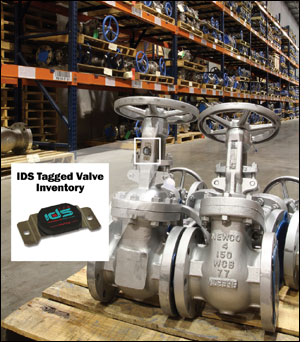
Counterfeit building materials is only one issue driving the industry's growing interest in RFID. Four years ago, when RFID Journal explored the construction sector, it was just beginning to deploy RFID to track tools on job sites to reduce loss and theft, keep tabs on workers to ensure their safety and productivity, and monitor the location and use of leased cranes, bulldozers and other machinery. Today, those applications are becoming more common on construction sites, and so is the then "promising" app: RFID for tracking building materials to keep construction projects on time and within budget. This has become more essential than ever since the economic downturn began. One of the newer applications in the construction industry tracks underground pipes and cables to reduce costly road excavations.
Supply Chain Visibility
Each construction project involves the coordination of a large number of people, a huge quantity and variety of materials, and fleets of trucks, machinery and tools. Building sites often consume acres of land, and it's a balancing act to have the needed people, materials and equipment in the proper location at the right time. Delays can have a significant impact on the efficiency, profitability and reputation of construction firms.
The New Meadowlands Stadium in East Rutherford, N.J., which opened in April, was a massive $1.7 billion project to create a new home for the New York Giants and New York Jets football teams. The project, designed and constructed by Skanska USA Building, was fast-tracked and built while the former stadium was still in use and the parking lots were needed for cars. This required Skanska to have visibility into its supply chain to ensure just-in-time delivery of necessary building materials, since the site did not have the typical "lay-down" yard for storing supplies.
Starting in late 2007 and extending through completion of the project, Skanska had the concrete pieces RFID-tagged at the fabrication plant and then tracked. The tag on each piece was read by RFID readers communicating with a tablet PC running Vela's Materials Tracking software at four phases of the production process. The RFID information was also incorporated into the BIM software—different colors indicated where pieces were in the supply chain, their quality assurance status, arrival at the site and installation.
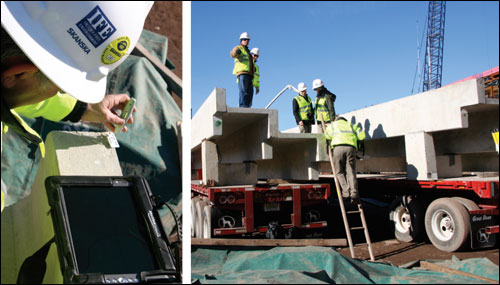
"We needed to monitor production to determine if it was following the required sequencing of installation," says Nery Pascoa, Skanska's quality-control manager on the project. Understanding where the materials were in the supply chain so the company could better plan for installation saved 10 days of project time, he says. At a cost of $100,000 a day, that saved $1 million.
Delays on construction projects are not only costly, they also can lead to finger pointing between contractors and suppliers.
That's one reason Standard Supplies, of Gaithersburg, Md., a provider of construction materials and structural steel fabrication to professional contractors, now RFID-tags fabricated steel through the production process and on to delivery to construction sites. "The good thing about putting a tracking tag on is that we can see if a piece is in fabrication, delivered to the job site or on a truck somewhere en route," says Standard Supplies' CEO, Deborah Murphy. "It's a communications tool. It's a way for the general contractor and me as a fabricator to communicate so we can all see where the pieces are."
On the construction job site, RFID also can cut the time craft workers spend searching for building materials, machinery and tools, as well as improve safety conditions. "Sometimes there are crews or equipment that remain idle because they can't find a critical component, or sometimes equipment is lost or missing," says David Grau, an assistant professor at the College of Engineering at the University of Alabama. "The highest impact of RFID, at least from my work, would be in tracking, identification and increased visibility of material components and tools. This can save large amounts of money." Grau has been working on several RFID pilots with FIATECH, a consortium of engineering and construction industry leaders, to track tools, equipment and material components around lay-down yards on industrial construction projects.
During construction of the Sandow Steam Electric Station Unit 5, a $750 million power plant in Rockdale, Texas, completed in 2009, Grau and colleagues compared conventional manual-based tracking processes by workers in the yard with RFID and GPS-based tracking. During a nearly three-month field trial, two almost identical steel boiler structures were constructed—one by workers manually tracking steel beams and columns, the other by workers using RFID to track the same materials.
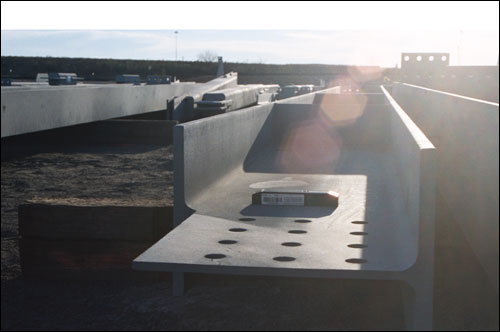
The manual tracking involved dividing the yard into grids, hand-marking components when they were delivered at the yards, and recording where on the grid those components were stored (and if they were moved)—then entering the information into a computer-based materials-management program. The automated tracking involved attaching active RFID tags to individual structural steel components; a roving crane or utility vehicle fitted with RFID and GPS receivers then moved through the site on a daily basis to collect data about the components' locations.
When the two crews were asked to retrieve components for installation, the crew using manual tracking required eight times longer, on average, than the crew using RFID and GPS, Grau says. And the number of components the manual crew wasn't immediately able to find was 18 times higher. For this project, the use of RFID saved the construction firm $273,257; the cost of RFID tags was $145,050.
A growing concern in the construction field involves efforts to improve on-the-job worker safety, whether that means restricting access to tools and hazardous locations or better maintenance of construction equipment. In the United States, construction workers represent about 8 percent of the U.S. workforce, but the sector is responsible for 22 percent of worker fatalities each year—the largest for any industry, according to the National Institute for Occupational Safety and Health, which is researching ways to improve safety. In the United Kingdom, about three million days were lost in the construction industry as a result of industrial injury and work-related illness in 2008-09—that's about 1.4 days per worker.
After the new regulations went into effect, Metal Decks (SMD), based in Dorset, a leading U.K. structured decking and flooring specialist, worked with CoreRFID to devise an RFID solution to track maintenance performed on safety nets designed to protect employees from high falls. By RFID-tagging each safety net, the company keeps tabs on how long each net has been in use, whether it has been exposed to ultraviolet light (which leads to deterioration) and whether it requires inspection before a worker checks it out. SMD is using the system as it installs decking at London's new Olympic Stadium.
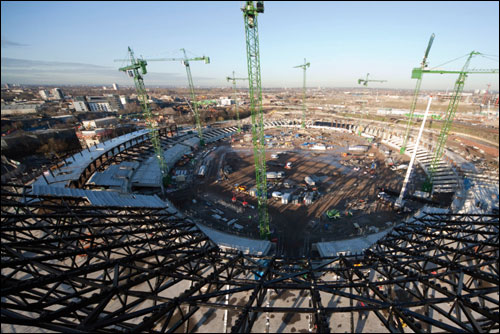
RFID can also provide an audit trail to help U.K. construction firms and equipment suppliers comply more easily with the regulations. Magnor Plant, a Warwickshire firm that provides lifting equipment—chains that attach to cranes to haul heavy items to construction sites, for example—sometimes has as many as 6,000 pieces of equipment at a site. It worked with Assettagz, an RFID tag supplier, to replace a manual inspection process, which could take three or four days to input into a computer program.
Some firms are taking a different tact to protect workers. Costain Group, an international engineering and construction firm, is using RFID to restrict worker access to tools for which workers have completed training. The company, which is undertaking one of the largest road improvement projects in the United Kingdom, the Church Village Bypass in South Wales, is not only tagging tools to avoid loss or theft, but to verify that workers have been trained to use those tools, says CoreRFID's Williams, whose company designed the application. "If you go to the tool store and say, 'Give me a jackhammer,' and you're not certified as having been trained on that device, they won't issue it to you," he explains. "It's a way to prevent people from hurting themselves."
The Value Chain
The concept of tracking components from manufacture to installation—and beyond—is appealing to many stakeholders in the construction industry. Newmans Valve lets customers access the database of information tied to each RFID tag only to verify that a valve is not counterfeit. But customers have begun asking to access more data—such as where the valve was made, the product manual and testing data, says Newmans' Restovic, noting that the company is working with RFID solutions provider idsTag on a FIATECH pilot to test sharing RFID data throughout the supply chain. Future RFID applications could, for example, replace the paper-based processes needed to document building materials to meet regulatory and industry requirements, and allow building owners to quickly order replacement parts, perform maintenance on a part or access a detailed product history.
Engineering and design firms, which often shepherd construction projects from conception to delivery for clients, are interested in RFID's potential to provide electronic documentation of construction materials and components as required by regulatory agencies and industry groups. Documentation—testing data, certifications, product history and inspections, for example—must be turned over to building owners after the completion of a project, and these paper documents can take up a whole room. Searching that paper trail for one piece of data also can be a nightmare.
"The key word here is traceability," says John Fish, VP of business development and quality assurance for Ford Bacon & Davis, an engineering firm. "All this paper has to be maintained, but if I have an RFID tag and couple that with some software, I can maintain all this paper electronically in a cloud computing application." When it's time for the engineering company to turn over the paperwork to the building owner, it's a matter of providing access to the electronic records.
Many challenges to adopting RFID in construction have been overcome by the development of better, inexpensive passive rugged tags that can withstand harsh environments and on-metal tags. But obstacles remain. Some companies say they still can't justify the cost without proof they will see a return on investment. Others are fearful of new technology they don't quite understand.
Bickford says FIATECH is attempting to alleviate some of these concerns by preparing a book that is two years in the making about how construction firms can get started using RFID for materials management and productivity improvements, as well as best practices from companies that have deployed the technology. The group also is working on documenting ROI from RFID case studies, including some of the pilots it is sponsoring, she says.
"The number-one concern is to protect their huge investment by making sure the right product is in the right place," says Newmans' Restovic. "If you have to shut down a whole unit because you got the wrong part or because you didn't have the right information, that can be costly. Some of these plants generate $1 million a day in revenue, and it's important that they have the quickest route to fixing a problem."
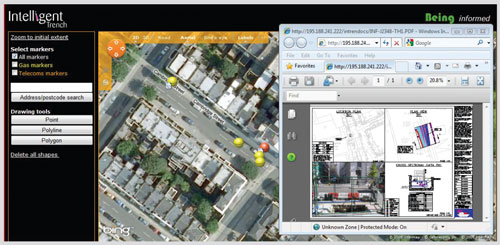
RFID Marks the Underground Spot
All too often, construction crews dig up a site only to find the underground pipes and cables they need to repair aren't in the location they're excavating. In fact, the construction industry has a term for this waste of labor, money and time: "dry dig." Now some utility and telecommunications companies, as well as municipalities, are implementing locating solutions to reduce the incidents of dry digs. By RFID-tagging subterranean pipes and cables as they are installed or repaired—and combining that information with GPS coordinates—crews can verify their location before taking up a jackhammer. They can also share that location information with other crews working in the area over a Web-based database, to lower the risk of accidentally rupturing a buried pipe or cable, damaging the asset and harming workers and others.
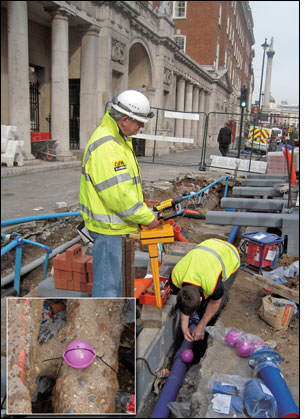
Last September, London's City of Westminster launched a pilot project to use RFID-enabled markers and GPS to identify and manage underground municipal water pipes and electrical cables. Intelligent Trench, a collaborative solution from Bentley Systems, 3M, Infotec and Trac-ID, enabled the city to pinpoint the location of its underground assets with GPS coordinates and handheld RFID readers, and verify their position and depth in a software database. Westminster officials are now deciding whether to implement the locating system citywide.
"In terms of cost savings, it's possible to reduce the incidences of dry digs if you are more certain to be sending people to the right location," says Steve Voller, Bentley's director. "The more strategic goal is to provide information to a city, region or country, so anyone planning work can go into a system and see who has underground apparatus in that locality." That could reduce exploratory digging and accidental damage to other underground assets by encouraging more use of noninvasive surveying techniques, he adds.
The passive RFID tags, encased in plastic marker balls, store only a unique identifier and a date, but the identifier could be used to compile information about when maintenance work is done and by whom, Voller says. British laws require documentation of underground assets and allow governments to force entities to pay for resurfacing a roadway if a trench isn't properly repaired after utility work. "It's rather an administrative hassle," he says, "and some companies are paying up even though they're not sure they were the last ones in the trench."
Down the road, the ultimate beneficiaries may be motorists. "Excavation work is very disruptive," Voller says. "It ties up traffic."


